Recent Updates
05/30/2025 12:00 PM
Official: Toyota to build GR Corolla in UK
05/30/2025 12:00 AM
First official pictures of new Jeep Cherokee ahead of 2026 launch
05/30/2025 12:00 AM
Change for the wurst: VW puts best-selling sausage in supermarkets
05/29/2025 12:00 PM
Volvo EX40 long-term review
05/29/2025 12:00 PM
Hyundai i10
05/29/2025 12:00 PM
EV charger installations no longer require planning permission
05/29/2025 12:00 PM
Autocar partners Siemens for 2025 awards and software webinar
05/29/2025 12:00 AM
New BMW i4 M60 brings more power than petrol M4 CS
05/29/2025 12:00 AM
Skoda Favorit reimagined as ‘minimalistic’ EV for new age
05/29/2025 12:00 AM
Alpine confirms V6-powered Ferrari SF90 rival for 2028
EV, Hybrid, Hydrogen, Solar & more 21st century mobility!
 Could Gothenburg’s lowest-profile EV also be its best? We aim to find out
Could Gothenburg’s lowest-profile EV also be its best? We aim to find out
Why we're running it: To see i f this veteran might actually be the pick of Volvo’s growing, tech-first EV range
Much of the talk surrounding Volvo concerns its evolving model range, headlined by the addition of the electric Volvo EX30 crossover and Volvo EX90 flagship SUV.
But the Swedish firm’s first production EV has also been transformed in recent years – to the point that it’s been rebranded as the EX40 to differentiate it from its petrol-powered Volvo XC40 sibling.
The XC40 Recharge was launched in 2019, which is several generations ago in the fast-developing world of electric car technology.Â
That’s forced Volvo to make significant upgrades, although they can go only so far. For example, the infotainment in the EX40 remains an older generation than in the EX30 and EX90, in which virtually all of the controls have migrated to a screen. Of course, for many buyers that old-school design could well hold plenty of appeal.
All this has left Autocar's latest long-term test car, for better or for worse, feeling a bit old-tech by comparison. That said, it’s still based on parent company Geely’s Compact Modular Architecture, which it shares with the much lauded Polestar 2.
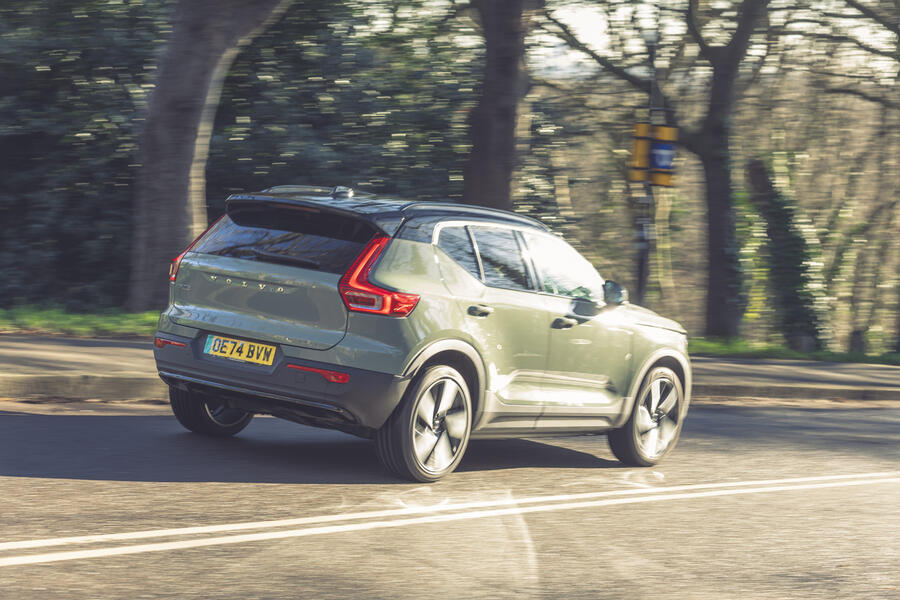
The updated car looks almost identical on the outside to the XC40 Recharge, but some important changes have been made under the skin. While the old model was front-wheel drive, single-motor EX40s instead have a powered rear axle, which should theoretically improve efficiency.
Our car is a Single Motor Long Range model, with a 78kWh battery giving it an official range of 340 miles and putting it between the 69kWh Single Motor (295 miles) and 82kWh Twin Motor and Twin Motor Performance models (332 and 326 miles) in the EX40 line-up.
That in theory should be enough to last me an entire week with my driving schedule, but this report is being written during winter, so I’m not going to be complacent. After all, the EX40 is a heavy beast (2001kg) and its boxy silhouette doesn’t exactly lend itself to peak aerodynamic performance. That a lone is a recipe for low efficiency, and while I’ve previously driven EVs through the coldest months without heating, those spending over £50,000 to buy this car understandably won’t want to compromise their comfort in return for a respectable range, so the climate control will be glued at a toasty 21deg C until the sun decides to come out again.
Over its first few hundred miles, the EX40 has self-reported use of around 38kWh per 100 miles, which equates to about 2.6mpkWh, or 205 miles of range – a full 135 miles below the advertised figure. At least charging speeds aren’t quite so miserly – the quoted 185kW easily beats the Skoda Enyaq (125kW) and BMW iX3 (155kW).
While efficiency may be an early concern, the EX40’s performance is not. Even this Single Motor version makes 252bhp and 310lb ft, good for a 0-62mph time of 7.2sec. I suspect that will be plenty fast enough for buyers of this kind of car, who will also appreciate the smooth delivery of that power. At least as importantly, it’s so far proving to be a very comfortable cruiser over longer distances too.
The interior is also full of promise. Like the exterior design, it’s almost identical to that of the XC40 Recharge so doesn’t subscribe to the minimalist, hands-free ethos of the EX30 and EX90 – yet. It almost sounds silly to draw attention to such things at this point, but the steering wheel has buttons for quick access to multimedia functions and the cruise control and our car has a modest 9.0in portrait infotainment touchscreen, paired with a 12.3in digital gauge display.
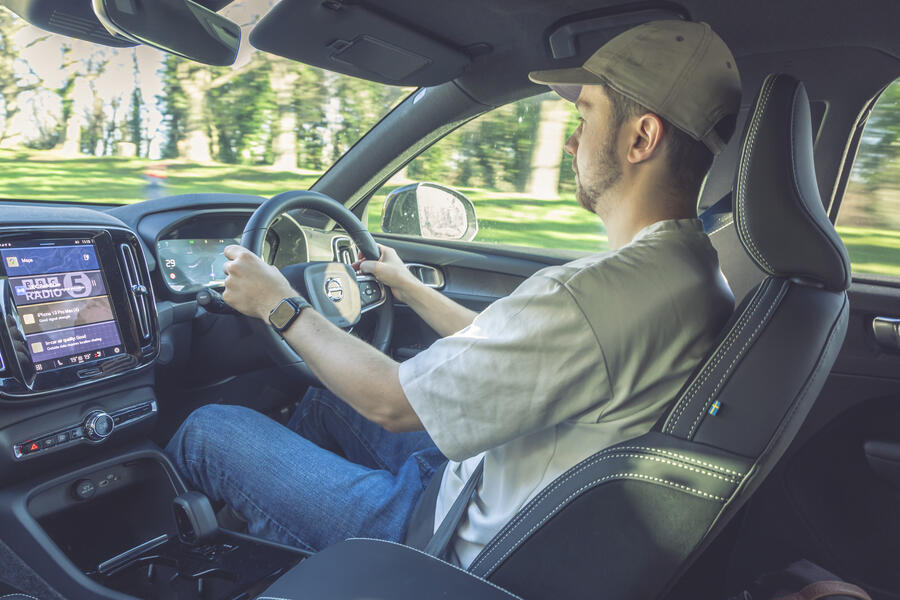
Both displays are crisp and clear, and Volvo’s Google-powered user interface remains one of the best – although many functions, including Google Assistant, Maps and Play Store (for downloading apps), will demand paid subscriptions after four years. Regardless, it’s so well integrated that I haven’t even considered using the standard Apple CarPlay. I can just get into the car and forget about my phone for the duration of the journey. Bliss.
Plus trim, the middle one between Core and Ultra, is well equipped. In addition to wireless phone charging, heated seats and a reversing camera, it gets air purification, adaptive cruise control, 19in alloy wheels and keyless entry. And I’ve already had some highly satisfied passengers, because Plus also offers rear heated seats – quite a rarity.Â
Early complaints? The EX40’s low-speed ride is a bit unsettled and road noise is pronounced. Handling is on the numb side too, but that’s hardly surprising given it’s positioned as a relaxed family runner, not a Hyundai Ioniq 5 N rival.
So far then, the EX40 on the whole feels as impressive on the road as it looks on paper. Whether it goes nearly as far on a charge as the brochure says it will may prove the deal-breaker. We will see.
Update 2
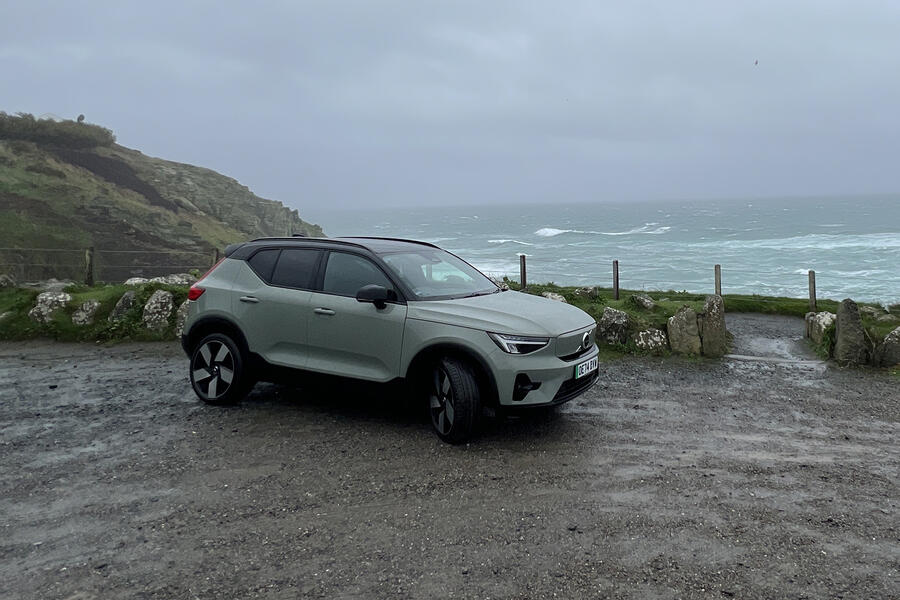
Shortly after starting life with a new car, it’s become a ritual for me to take it on a south-westerly trip across the country to get properly acquainted.
Our Volvo EX40 comes with the larger, 79kWh battery that is claimed to offer a range of up to 340 miles, so there was initially some hope that I’d make it the full 302 miles from north London to Lizard Point without stopping. The plan never stood a chance, however, once a meagre ‘220 miles’ appeared on the range display as I set off.
That was enough to get me to my usual stopping point of Exeter services, where a Gridserve charger replenished the battery from 10-80% at a peak rate of 145kW (not far off the EV’s claimed 155kW maximum). It meant I didn’t have to sit in the car park for more than 30 minutes during the worst storm of the year.
The journey itself was silky smooth. This Volvo’s ride quality over long distances is excellent, with its cosseting front seats and unobtrusive ADAS technology helping to shrink hours-long drives.
Its 252bhp electric motor was more than a match for the hilly A303 and faster A30, but it was here that efficiency took a big hit. The EX40 returned an economy of 2.4 miles per kWh for the duration of the journey. That’s equivalent to around 190 miles of range – nowhere near the WLTP figure.
It’s a world away from the nearly 200kg-lighter Cupra Born I ran previously: that car routinely achieved 4.5mpkWh at highway speeds. But where the 2001kg Volvo has the Cupra beaten is refinement, in which area the EX40 has so far been hard to fault.
Those comfort seats, fitted as standard in Plus-spec models like ours, live up to their name and like the steering wheel are heated too, so I’m kept warm without being too reliant on energy-sapping climate control. This electric SUV does a good job of nullifying wind and road noise too. The EX40 certainly stakes a strong claim to being among the most refined and relaxing models in its class.
Unlike in the newer, more technologically advanced Volvos on sale today, the EX40 ’s safety kit leaves you largely to your own devices, and its software doesn’t intrude. Switch off the lane assist, driver monitoring and other handholding systems, and they stay off.
The only feature that switches on (owing to European legislation) each time you start the car is the speed limit warning, which for me isn’t a problem. The system reads roadside speed limit signs and motorway gantries effectively, and it augments that with GPS data. It ’s actually quite handy to have in London, which is beset with continually changing speed limits. Over 2000 miles so far, I have yet to experience any difficulties or erroneous speed limit detection.
While most of the tech is simple to use and (for the most part) effective, it’s not perfect. The regular cruise control works well, but the Pilot Assist system takes some getting used to. It is in effect a semi-autonomous cruise control that can support braking, steering and acceleration, but it feels a bit odd in practice. It lacks the smoothness of BMW’s Active Cruise Control: the steering wheel jerks around in small increments rather than with intuitive movements, and drivers behind must think I’m correcting my steering way too often. When news editor Will Rimell ran an XC40 Recharge (as the EX40 was previously known) in a different spec, he had no issues with the same system and suggested it made his commute far easier, so I’ll persevere with it to see if my thoughts change.
One frustrating feature I doubt I’ll get used to is the automatic braking system that functions when reversing. It detects obstacles to the side of the car and immediately behind, plus traffic when you’re backing out of a parking space. It also seems to detect ghosts: often when I’m reversing, it will apply the brakes jarringly for no reason, both spooking me and making me look like a buffoon. Still, it ’s a fairly minor gripe that takes little away from the EX40’s overall charm.
Update 3

No matter how clean and tidy you think you are, moving house always highlights how much tat you own. These occasions can expose a flaw in many small SUVs: practicality. Some, despite their raised ride height and perceived capaciousness compared with a conventional hatchback, actually have no more interior space.
My electric XC40 has decent but not class-leading practicality, according to the official figures, which I put to the test when I moved out of my north London flat with two years’ worth of accumulated cargo.
My makeshift removal vehicle has a 452-litre boot. That ’s some way from being the biggest in the class, beaten easily by the Kia Niro EV (475 litres) and BMW iX1 (490 litres) and positively outclassed by the Tesla Model Y (854 litres – although Tesla cheekily includes space above the parcel shelf ). Fold the rear seats down flat, however, and there’s a reasonable 1328 litres to play with.
The EX40’s boot is generally a practical and usable space. With a wide opening and square shape, it’s ideal for shifting furniture and boxes. I squeezed in a dresser, an air fryer, three boxes of clothes and a bedside table easily, and the 252bhp electric motor had no trouble coping with all the extra weight.
I unexpectedly found a use for the tiny 31-litre ‘frunk ’, too. Turns out it’s perfect for half a sourdough loaf and some lunchboxes.
If I had one complaint, it’s that the rear doors have a narrow opening, so it can be hard to squeeze larger, rigid items in. Some reshuffling ensued, if only as a result of my own poor planning.
On the 80 -mile route back to my temporary accommodation – my parents’ house – the EX40 showcased its exemplary ride quality. London’s roads are rubbish – no secret there – but believe it or not the roads in this corner of Berkshire are even worse. In our village, potholes are more like trenches and cracks in the road resemble canyons. Yet the EX40 remained composed and cosseting and my treasured commemorative glassware remained undamaged.
The EX40 performed valiantly throughout the move, but despite a successful first run I succumbed to hiring a van for the rest of my stuff.
All of it will now sit in my parents’ garage for two weeks (much to their dismay) until I can pack up and do it all again. After the EX40’s positive initial showing, it may have earned itself a full day’s work next time out.Â
Update 4

Moving from a shared house to an unfurnished flat has meant I’ve had to buy furniture, cutlery and lots more besides, and because I currently run a Volvo, I knew there was only one store for the job. Okay, I’ll admit I chose Ikea for its prices rather than its provenance, but it was a nice coincidence nonetheless.
So, another practicality challenge for our resident Swede: Poängs, Färgklars, Vardagens – you name it, it would all have to be squeezed into the EX40’s 452-litre boot. And, once again, the car proved itself worthy – although I did have to lower the rear seats to liberate all 1328 litres.
I was feeling quite smug until my colleague and fellow shopper Sam Phillips arrived in his 128,000-mile 2011 Ford Focus and seemed to fit at least as much stuff in the back of it. And that was with a mere 316-litre boot, increasing to 1215 litres with the rear seats folded flat.His cargo included two wardrobes, a bedside table, an office desk and a lamp, albeit boxed up in classic Ikea flat-pack fashion.
The Volvo has spent most of the past few weeks quietly and effectively undertaking similarly mundane duties. The excitement has come from my 2017 Mk7.5 Golf GTI (manual, if you’re asking), which I bought back in March.
Of course, comparing two very different cars would be unfair, but driving a hot hatch legend has only served to emphasise one of the EX40’s biggest shortcomings: its handling. As a result of its raised height and two-tonne weight, the SUV leans significantly when cornering, and there’s not much room for adjustment, either.
There are just two steering settings, standard and firm, the latter of which adds a bit of weight but little in the way of dynamic ability. And, unfortunately, while the ride is largely settled, it ’s not much better than that of the low-riding hot Golf, either.
On the other hand, even the GTI can’t match the instant power of the EX40, and the EV is inevitably better equipped with the latest technology.
The EX40 has another card up its sleeve. Parking in the south-west London neighbourhood I’ve moved to requires a resident’s permit. A pain in the backside, but the council has at least included some incentives to ease the burden. Being electric, the EX40 has a Band A classification and thus is eligible for a cheaper rate. A standard permit is £108.50 for the year, but I’ve paid just £54.25.
More problematic is the limited number of rapid-charging stations in the area. According to Zap-Map, there’s a fair discrepancy compared with other parts of London.
Within a few miles of my flat, there are six fast chargers, three of which are inaccessible on private land, while another is at a garage and has been out of service for months. The other two are at a McDonald’s three miles away, so it might be time to explore the world of lamp-post chargers, unless I can stand going up a few trouser sizes.
Goodbye
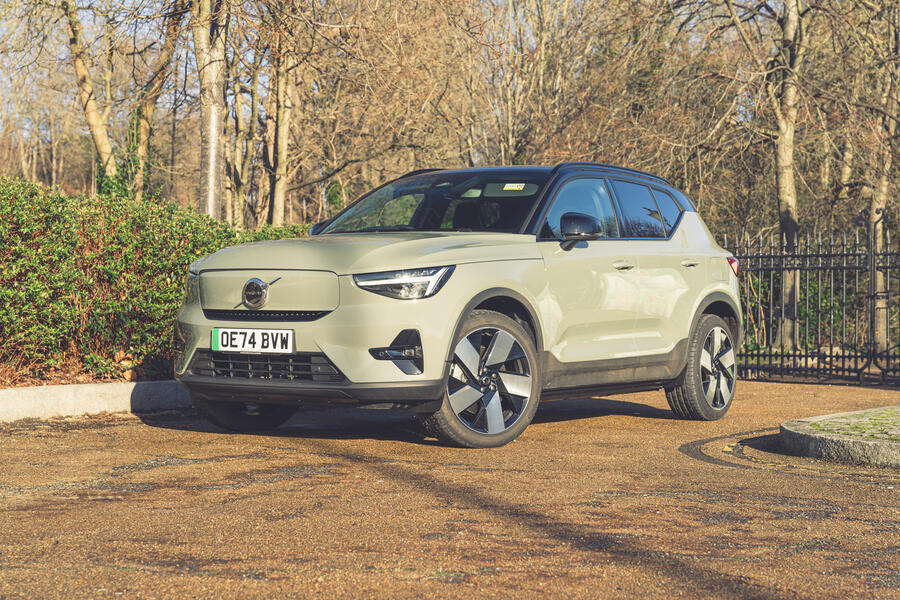
Such is the reassuring familiarity of a Volvo SUV that when this EX40 arrived on our fleet several months ago, I knew exactly what to expect: a dependable, refined, spacious tourer with a premium feel and a dash of Scandicool. It wouldn’t be tremendously exciting, but it would fit a brief that has kept plenty of buyers happy. And, as the EX40 departs, I’m pleased to say it delivered on those expectations – mostly.
To start with, the EX40 is one of the most accessible electric cars I’ve driven. A newcomer to EVs wouldn’t be intimidated to drive it, and it was expertly undemanding on the road. What it lacked in dynamism it made up for by making every journey straightforward and stress-free. Not a given in today’s tech-led cars.
That accessibility could be because the EX40 is so familiar, being based on the highly successful petrol-powered XC40. We have run a number of examples on our fleet over the years, ranging from pure ICE and plug-in hybrid XC40s to a dual-motor XC40 Recharge EV.This EX40 Plus Single Motor Extended Range is perhaps the ideal spec for an EV, since its combination of a single rear-mounted motor and the biggest battery in the line-up gives the longest range possible. The 252bhp offered is well down on the range-topping Twin Motor Performance model’s 436bhp but I found it to be comfortable enough for all day-to-day driving situations.
The feeling was reinforced when I got the chance to try a 402bhp dual-motor EC40. That model (essentially identical to the EX40 aside from the sloping coupé roofline) was sharper in the corners and clearly faster, but all its extra power felt unnecessary in a family SUV on UK roads.
My EX40 also felt more settled on country lanes, perhaps because it was rear-driven and a little lighter. I also welcomed the extra interior and boot space enabled by the EX40’s higher roofline, not least because I kept bashing my head on the EC40’s bootlid whenever I opened it. But that might just be me.
The EX40’s 452-litre boot served me well during our time together and helped me move house more than once, but it’s a fair bit down on the Audi Q4 E-tron (520 litres) and put to shame by the admittedly bigger Skoda Enyaq (585 litres). I couldn’t have asked for much more from behind the wheel, though. The EX40’s interior is practical and extremely relaxing. The suede textiles and Microtech upholstery and highly adjustable cushioned seats helped make all my journeys pass by in total comfort.
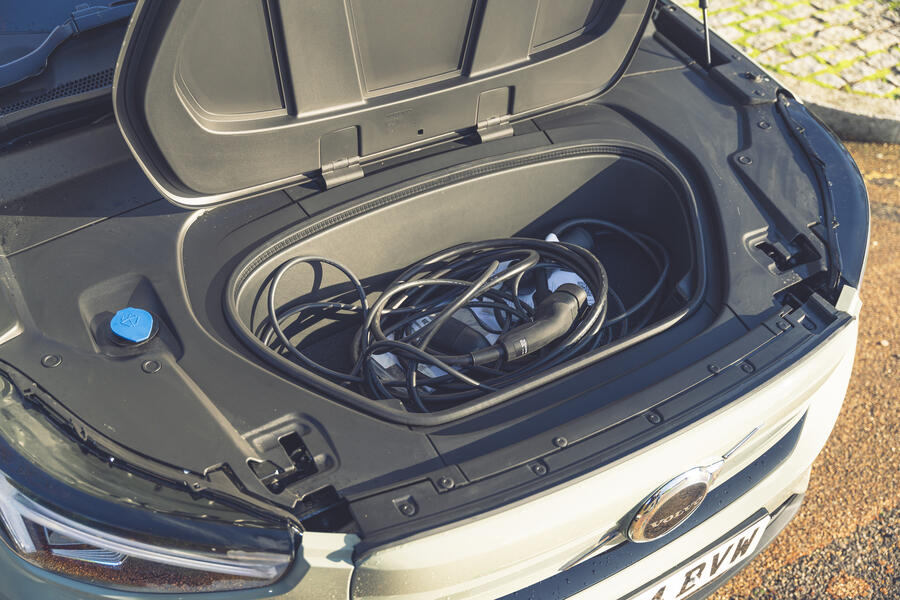
Comfortable inside and pleasantly undemanding to drive, then. What ’s not to like? Well, there was one glaring issue I encountered whenever I drove the EX40: efficiency.
Our car was fitted with the bigger, 82kWh battery, compared with entry-level models that come with a 66kWh pack. When it was delivered, our car had an official WLTP range of 340 miles, which is competitive for this class. Better still, a software update during its time on the fleet boosted this to 353 miles.
Sadly, I never saw anything close to that. And while most EVs fail to match their official rating in the real world, this EX40 simply isn’t competitive with newer, more efficient rivals, some of which can easily exceed 4mpkWh.
In 8000 miles of driving, I never saw more than 260 miles of range on my digital driver display. My average economy amounted to around 198 miles on a full battery. Even a peak of 268 miles was well down on the claimed range, pre-or post-software update. Winter driving was of course a factor, but things didn’t improve markedly once the weather warmed up.
Still, the charging speed was decent at 185kW, so I was able to get it topped back up fairly quickly.
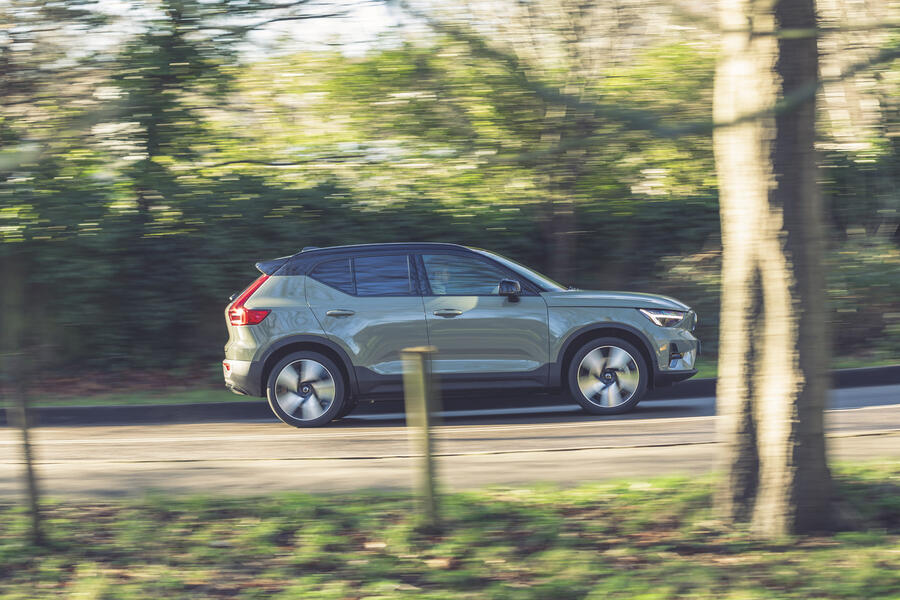
While parked up at the chargers I was able to fully explore Volvo’s infotainment system, which in my experience is among the easiest to use and one I will really miss. It has a Google-powered user interface, so I was able to log into my account and access all my saved locations and Google Maps search history.
The various downloadable apps even made those charging stops rather enjoyable: I watched videos on YouTube to keep me entertained, logged in directly to Spotify to access my music library and used the fireplace app to warm me up. It nearly made me forget I had the heating turned off in January to conserve range.
It was also a reminder that Volvo cars are increasingly becoming software-based, and that this EX40 is a bit of an outlier in a line-up now also including the smaller EX30 and the larger EX90.Â
If you’re already tempted by the EX40 and its range meets your driving needs, though, don’t let its age put you off. This is a compelling proposition, mixing intuitive and user-friendly technology with a bit of old-school Volvo charm.
